
At this point the car was putting out somewhere near 60 bhp, so the next step was obvious. During the winter of 1949 a 2 liter motor was fitted. Willis used the vertical valve, M319/4 Type 55 with triple horizontal Solex carburetors. Though not as effective as the hemi-headed 328 power plant, Willis and Bulmer modified it for more power along the lines they had used with the smaller engine. The car was also fitted with an ENV 75 pre-selector transmission from a Riley via a custom magnesium bellhousing.
To mark this new phase in its life the car was also re-registered as PVW 893.
The 1950 season showed that the car was now quite quick, and was, in fact, a match for the factory Frazer-Nashs and HMWs. But as Willis was now participating in more circuit races, it also showed itself to be unreliable. But given the team’s limited resources, this should hardly seem surprising.
That summer the team ventured to the Continent and raced in the Formula 2 events at both Luxemburg and Chimay, Belgium in May, and the 4e Coupe des Petites Cylindrees at Rheims in July. All these runs ended with DNF’s. These disappointments discouraged further forays to Europe, and resulted in the team focusing on races close to home.

By mid-summer the car was running more reliably. A second place finish to Gil Tyrer’s ex-Mille Miglia 328 streamliner at Silverstone in July, and a victory over Oscar Moore’s OBM at the SUNBAC Silverstone race in August were very promising. In September Willis returned to Prescott and climbed the hill in 50.48 seconds to win the 1500-3000 cc class. This time set a new record for the class, and was even good enough to beat Sydney Allard’s new Cadillac-Allard for the best time of the meet for sports cars.
1951 was pretty much like 1950, fast but fragile. 3rd behind an XK 120 Jaguar and a Frazer-Nash Le Mans Replica in June at Silverstone. Another 3rd behind two Frazer-Nash Bristols at Boreham in August, and a well deserved 2nd behind a Frazer-Nash High Speed at Gamston Airfield in July. The year ended with a disappointing DNF at the International Wakefield Trophy Race at Curragh in September.
For 1952 the team realized that they would need more power if they were to remain at all competitive in the 2 litre classes. So Willis set about modifying the Type 55 engine to accept a 328/Bristol type alloy cylinder head fitted with 3 down-draft SU carburetors. This change was immediate and dramatic.
Bulmer drove the car in the first event of the season, the Gosport ¼ Mile Sprint where his best time of the day was 14.97 seconds, sufficient to beat 2 Frazer-Nash Le Mans Replicas and garner the 5th fastest time of the day.
Sharing the car for the May AMOC Race at Snetterton, Willis easily took his heat race ahead of a Frazer-Nash Mille Miglia and a potent MG-Cooper, but had to retire from the final. Bulmer was leading the Formula 2 race until he blew a head gasket in the late stages of the race. Still he was able to set the fastest lap of the day at 77.92 MPH.

Two weeks later Willis posted a record time of 48.84 seconds at the Prescott Hillclimb. This was down from his initial time of over 62 seconds from just a few years earlier. Bulmer won the up to 2,500 cc sports car class and finished 2nd in the Formula 2 race at Silverstone at the end of May, followed by a 2nd in the Formula 2 race at Snetterton.
Three weeks later Willis faced a tough field of Formula 2s at the West Essex Car Club’s Boreham race. Led by Reg Parnell’s Cooper Bristol, 2 Connaught A-types, and a Ferrari 125/66, Willis finished a credible 5th, and in the process set a two litre lap record of 85.5 MPH.
